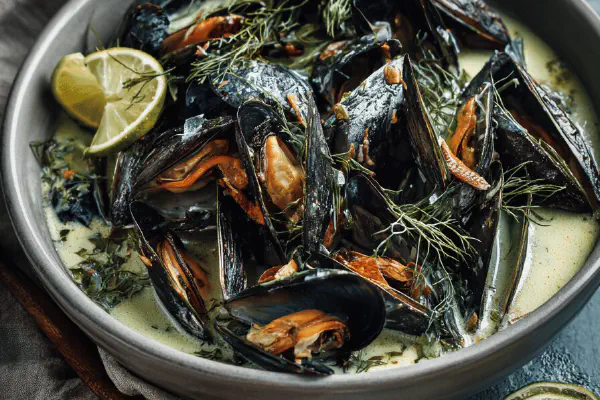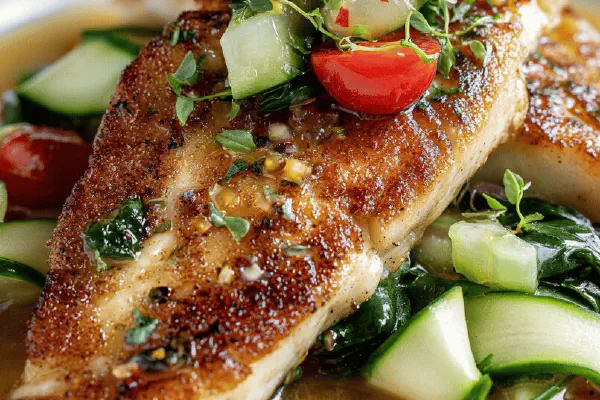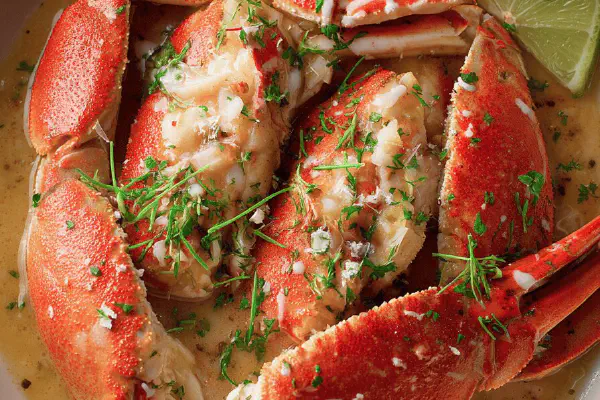Mussels in Creamy Coconut

By Emma
Certified Culinary Professional
Ingredients
- 1 shallot, finely chopped
- 1 garlic clove, minced
- 15 ml (1 tbsp) lemongrass paste or freshly minced stalk
- 15 ml (1 tbsp) olive oil
- 200 ml (slightly less than 1 cup) lite coconut milk
- 7 ml (1.5 tsp) honey
- 10 ml (2 tsp) fresh lime juice
- 1 kg (2.2 lb) mussels, cleaned
- Salt, to taste
- Fresh cracked black pepper, to taste
About the ingredients
Method
- Heat olive oil in a deep skillet over medium; the sizzling sound tells you it’s ready.
- Add shallot and garlic, stir gently until translucent, not browned - about 3-4 minutes. The aroma here sets the stage.
- Drop in lemongrass paste; stir to release its citrusy notes - it should smell bright but not overpower.
- Pour in the lite coconut milk - not full fat here; it’s about balance, getting the broth silky without heaviness.
- Sweeten with honey, stir until dissolved, then splash in lime juice for that sharp punch.
- Season lightly with salt and pepper; remember mussels bring briny punch so go easy now.
- Crank up heat until broth just begins to bubble - watch closely; too high will break the coconut milk.
- Toss in mussels quickly, cover immediately to trap steam and flavors.
- Cook 8-12 minutes; listen for shells popping open and gurgling broth.
- Shake skillet gently halfway to redistribute mussels, avoid overcooking—shells only just open means tender flesh.
- Discard any mussels remaining tightly closed - these won't save you from bitterness or crunch.
- Give broth a taste, adjust salt and pepper as needed; the balance of sweet, tangy, and salty is key.
- Ladle mussels and broth into warm bowls. The shell’s glisten and tender meat beneath tell you it’s ready.
- Serve immediately, soak it up with crusty bread or a light salad.
Cooking tips
Chef's notes
- 💡 Start medium heat. Olive oil warms till faint fruity scent. Key here is gentle sweat of shallots and garlic; not brown, just translucent. Lowish heat holds coconut milk steady later. Watch skillet rims for faint sizzle not roar. When lemongrass hits, stir quick. Citrus notes pop without overpower. Timing crabbed but audible cues important.
- 💡 Add coconut milk after aromatics. Keep heat below simmer or broth breaks—little bubbles along edges not full boil. Lite coconut milk chosen on purpose for lighter mouthfeel. Full fat curdles easily here. Honey first dissolves evenly, then lime juice sharpens without chunks. Stir patiently; grainy spots mean heat too high or hasty stirring.
- 💡 Mussels must be cleaned well; scrub shells and remove beards. Any gritty sand ruins it. Add to hot broth and cover straight away. Steam traps aroma and speeds opening. Shaking pan halfway isn’t optional; helps even cooking. Listen close for pops. If shells don’t open by 12 minutes, toss them. They taste bitter, chewy. Always better safe than sorry.
- 💡 Salt added last. Mussels bring natural brine, so go light early. Seasoning too soon hides true balance. Taste broth when shells open—adjust with cracked pepper and fine salt. Fresh cracked preferred for bursts of heat that work with lemon notes. White pepper is alternative if black feels strong. Secondary citrus source like lemon ready if broth flat. Brighten quickly with splash, no overpour.
- 💡 Serve immediately in warmed bowls. The broth cools fast. Shells glisten, meat firm but tender, indicating doneness. Use crusty bread to soak broth or fresh salad for contrast. Timing feels like an old rhythm; garlic-shallot base melts slowly, broth bubbles softly—not raging boil. Listen, smell, see. Rushing means tough, chewy mussels. Patience measured in sensory hits not clock.
Common questions
Can I use fresh lemongrass instead of paste?
Yes, but prep needed. Peel tough layers, mince finely. Paste preferred for quick release of citrus oils. Fresh stalks offer texture but more prep time. Flavor stable with paste. Both work though; adapt timing slightly.
What if coconut milk curdles?
Heat too high usually. Avoid rolling boil. Lower heat immediately. Stir gently to reincorporate if slight break. Use lite coconut milk; full fat more prone. Alternative: add coconut milk off heat after initial simmer. Watch heat closely, patience key.
Mussels don’t open after cooking?
Discard. Could be dead before cooking or old. Cooking longer won’t help, toughens meat. Risk bitter taste, unsafe textures. Fresh shellfish essential. Washing crucial to avoid grit. Cook time 8-12 mins typical, listen for pops and gurgle for doneness clues.
How to store leftovers?
Cool quickly, fridge up to 2 days max. Broth and shells separate or together. Reheat gently, no high heat or mussels toughen. Freezing not recommended—texture suffers drastically. Consume fresh best. For broth, strain and store separate; can use in soups or sauces later, but fresh preferred.



